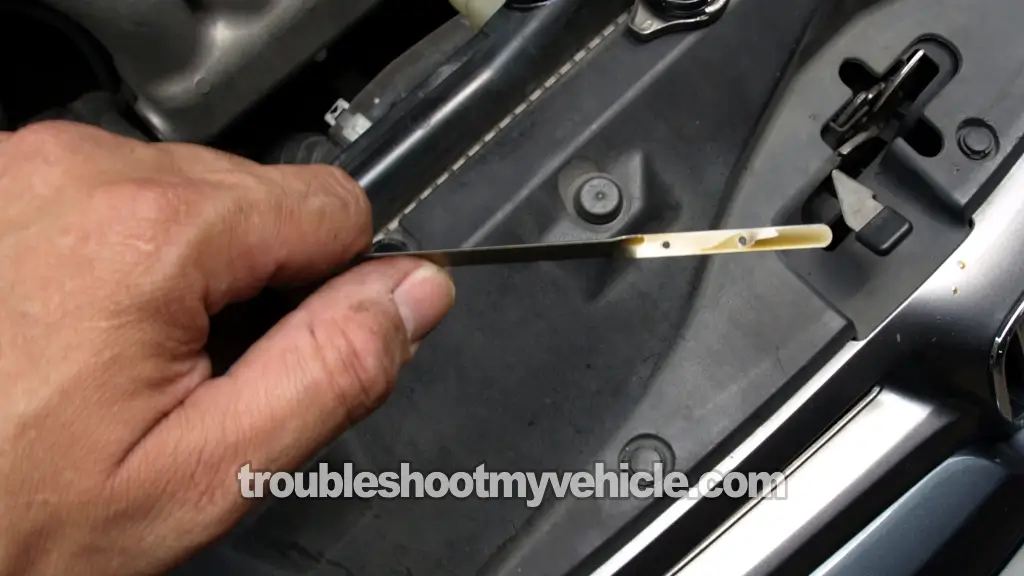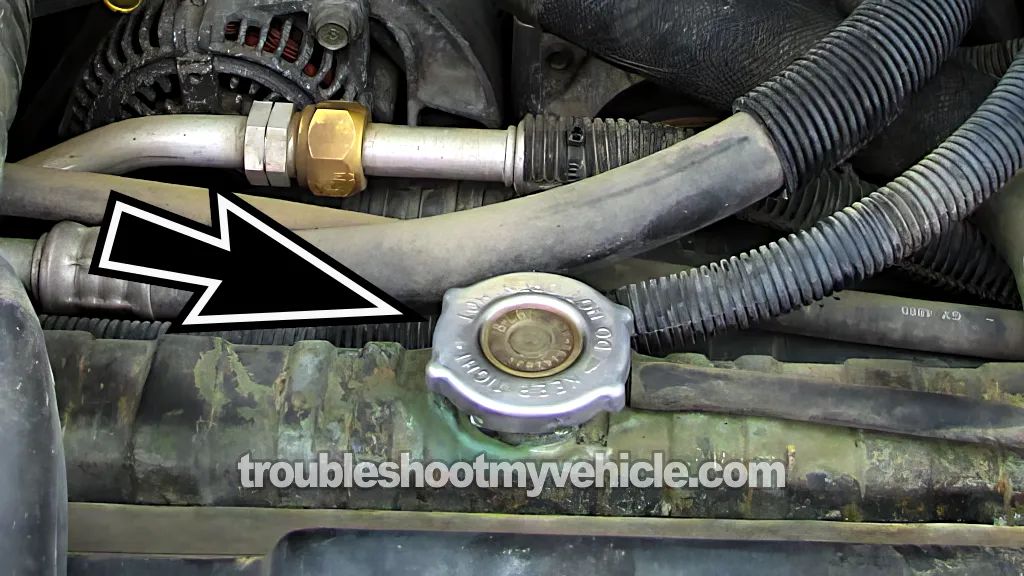
In this tutorial, I'm gonna walk you through the 4 most common ways to check if your van's got a blown head gasket.
Two out of the four are super simple —they don't require any tools and you can get them done in just a few minutes.
So if you've been wondering whether your Dodge Ram van might have a blown head gasket, I'll help you confirm it in step-by-step guide.
Contents of this tutorial:
- Symptoms Of A Blown Head Gasket.
- TEST 1: Oil The Color Of Coffee With Too Much Creamer.
- TEST 2: Exhaust Gases Shooting Out Of The Radiator.
- TEST 3: Cylinder Compression Test.
- TEST 4: Using A Chemical Block Tester (Combustion Leak Tester).
- Frequently Asked Questions.
- More 5.2L, 5.9L V8 Dodge Ram Van Tutorials.
APPLIES TO: This tutorial applies to the following vehicles:
- 1989-1994:
- Dodge Ram B150 Van 5.2L V8: 1989, 1990, 1991, 1992, 1993, 1994.
- Dodge Ram B250 Van 5.2L V8: 1989, 1990, 1991, 1992, 1993, 1994.
- Dodge Ram B250 Van 5.9L V8: 1989, 1990, 1991, 1992, 1993, 1994.
- Dodge Ram B350 Van 5.9L V8: 1989, 1990, 1991, 1992, 1993, 1994.
- 1995-1997:
- Dodge Ram B1500 Van 5.2L V8: 1995, 1996, 1997.
- Dodge Ram B2500 Van 5.2L V8: 1995, 1996, 1997.
- Dodge Ram B3500 Van 5.2L V8: 1995, 1996, 1997.
- Dodge Ram B2500 Van 5.9L V8: 1995, 1996, 1997.
- Dodge Ram B3500 Van 5.9L V8: 1995, 1996, 1997.
- 1998-2003:
- Dodge Ram 1500 Van 5.2L V8: 1998, 1999, 2000, 2001, 2002, 2003.
- Dodge Ram 2500 Van 5.2L V8: 1998, 1999, 2000, 2001, 2002, 2003.
- Dodge Ram 3500 Van 5.2L V8: 1998, 1999, 2000, 2001, 2002, 2003.
- Dodge Ram 1500 Van 5.9L V8: 1998, 1999, 2000, 2001, 2002, 2003.
- Dodge Ram 2500 Van 5.9L V8: 1998, 1999, 2000, 2001, 2002, 2003.
- Dodge Ram 3500 Van 5.9L V8: 1998, 1999, 2000, 2001, 2002, 2003.
Symptoms Of A Blown Head Gasket
The most frequent reason one or both head gaskets fail is due to the engine overheating, which can happen because of:
- Faulty fan clutch: The fan clutch has stopped functioning properly and the engine isn't getting cooled.
- Coolant loss: All the coolant leaked out, and the engine was still driven in that condition.
- Stuck thermostat: A defective thermostat got stuck in the closed position, preventing coolant from flowing through the cooling system.
Here are the most common signs that you've got a blown head gasket on your hands:
- Overheating engine: Your Dodge van's engine is running hot —and you've already ruled out issues with the water pump, fan clutch, or thermostat.
- White exhaust smoke: There's white smoke coming from the tailpipe, and it has that telltale sweet scent of burning antifreeze.
- Engine won't start: Your Dodge van's engine cranks but won't fire up.
- You've confirmed the ignition system is fine —you're getting spark at every spark plug wire.
- You've also verified that the fuel system is working —the fuel pump is working.
- Milky engine oil: The oil on the dipstick has an off-white color —a clear sign that coolant has mixed with the oil.
TEST 1: Oil The Color Of Coffee With Too Much Creamer

Chances are, you won't need to run all four tests I'm covering in this tutorial to figure out whether the head gaskets on your V8 Dodge Ram van are blown.
If the first test gives you a clear yes (confirming a head gasket is toast) you can skip the rest.
Alright, let's jump in and get started with our first test:
- 1
Pop the hood on your Dodge Ram van.
- 2
Locate and remove the oil dipstick from the engine.
- 3
Take a close look at the oil —check both the color and thickness.
- 4
You're gonna see one of two things:
1.) The oil looks milky-white —a creamy, off-white color and thick like syrup.
2.) The oil looks normal —the usual dark/dirty color and consistency.
Let's break down what each of these results means:
CASE 1: The oil has a light tan color, kind of like coffee loaded with creamer. That's a solid sign you've got a blown head gasket.
Here's what's going on: Your engine likely overheated and this happened:
- The cylinder head —or both heads — warped from the heat. That warping damages the head gasket.
- Once the head gasket is burned or compromised, it can't seal off the coolant and oil passages between the block and the cylinder head.
- This allows coolant to seep into the oil pan. When coolant and oil mix, you end up with that thick, creamy off-white looking mess on the dipstick.
CASE 2: The oil looks clean and normal. That's good news so far —now it's time to check for combustion gases leaking into the cooling system. Head over to: TEST 2: Exhaust Gases Shooting Out Of The Radiator.
Here's why this next test matters: In most cases (around 90% of the time), a blown head gasket will let coolant mix with engine oil. But not always. Sometimes the gasket fails in a way that lets compression or exhaust gases sneak into the radiator —and that's what we'll check for next.
TEST 2: Exhaust Gases Shooting Out Of The Radiator

The second most reliable test to determine whether a head gasket on your V8 Dodge Ram van has failed is to check for compression or combustion gases escaping into the cooling system.
Like the first test, this one is very straightforward and doesn't require any special tools. You do have to keep one thing in mind and that is that it has to be done with a cold engine (if the engine starts).
IMPORTANT: This test should only be done when the engine is completely cool. If the van has been running, give it at least an hour to cool off. Otherwise, you could be burned by hot coolant —safety first.
Here's how to perform the test:
- 1
Take off the radiator cap.
- 2
Check that the radiator is completely full. If it's low, top it off with water.
- 3
With the cap still off, ask a helper to crank the engine while you observe the open radiator from a safe distance.
- 4
You'll see one of these two outcomes:
1.) The coolant inside the radiator will shoot up or bubble out aggressively.
2.) The coolant remains still —cranking the engine doesn't disturb the water level at all.
Let's go over what your result means:
CASE 1: Coolant bubbled or burst out of the radiator. That's a clear indicator that combustion gases are leaking into the cooling system —confirming a blown head gasket. No need for further testing at this point.
CASE 2: Coolant stayed undisturbed (didn't move). That's a good sign, but it doesn't give us 100% certainty just yet the head gasket are OK.
We need to dig a little deeper:
- If the engine starts but overheats within minutes, head over to: TEST 4: Using A Chemical Block Tester (Combustion Leak Tester).
- If the engine starts and runs with a misfire, head over to: TEST 3: Cylinder Compression Test.
Now, you might think it's always obvious when a head gasket is blown —that there'll always be milky-white colored oil or coolant getting shot out of the radiator. But sometimes, these symptoms don't show up. That's why the next two tests are key —they'll give you the final word on whether your head gaskets are actually in the clear or not.
